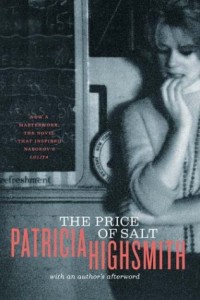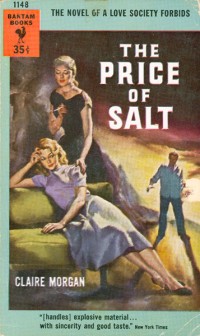Recommended Read: "The Price of Salt" by Patricia Highsmith
 One of the four novels I resolved to read this year is Patricia Highsmith's The Price of Salt. I read it while traveling for the Diversity Tour, and I've been meaning to blog about it ever since I finished. Overall, I really enjoyed it. It surprised me constantly, for many reasons.
One of the four novels I resolved to read this year is Patricia Highsmith's The Price of Salt. I read it while traveling for the Diversity Tour, and I've been meaning to blog about it ever since I finished. Overall, I really enjoyed it. It surprised me constantly, for many reasons.
First and foremost, I was stunned that this book was published in 1952. I've always envisioned the 1950s as this Leave It to Beaver world of perfect white nuclear families who are very prim and proper, but of course that's just the upper middle-class myth. Obviously, people in the 1950s had love lives and desires and were just as reckless as people in any decade. And obviously, gay people existed then, too, but I'd always envisioned them as secretive, depressed people in an oppressive, closeted world full of homophobia. The Price of Salt suggests that there might have been an alternative — especially for women who could pass as straight, but who definitely were not.
The novel is about nineteen-year-old Therese Belivet, an aspiring stage designer living in New York and supporting herself by working at a toy counter in a department store. When Therese sees a wealthy housewife across the sales floor, she is immediately drawn to her, and soon afterward they begin a friendship. Carol Aird, the housewife, is in the midst of a divorce, and as her relationship with Therese develops, it becomes clear that both women are interested in being more than friends. Eventually they go on a cross-country road trip together that reminded me a bit of Thelma and Louise, and had kind of a crime caper feel to it.
I was surprised by how frankly Highsmith wrote about the women's relationship. Therese's attraction to Carol is always crystal clear, and there is never a hint of internalized homophobia in her. Therese accepts her attraction and love for Carol from the get-go; she doesn't seem to have the tiniest problem with it, although Therese is aware that others could object.
Carol's feelings for Therese are a little more opaque at first, probably because the story is mostly told from Therese's point of view. But Carol is also older than Therese — perhaps ten years older? — and she has already had one lesbian relationship end. Carol knows that it's difficult and potentially tragic to fall in love with another woman, and for a time, she seems to resist, although she can't help being drawn to Therese, either.
I usually find it difficult to buy into love-at-first-sight tales, and I wasn't entirely sold on it by The Price of Salt. But the fact that it was a lesbian love at first sight (which I hardly ever read about) made me try harder than usual to buy into the romance.
However, it was difficult for me to feel the chemistry between the two women, even though Therese was continually describing Carol in rapturous tones. I think this is because I did not initially like Therese very much. The book opens up with a couple of tedious chapters setting the scene and describing how bland and hopeless Therese's life is. The moment she meets Carol does not happen until page 39, and by then I'd decided that Therese was a bore. Here is their meeting:
Their eyes met at the same instant, Therese glancing up from a box she was opening, and the woman just turning her head so she looked directly at Therese. She was tall and fair, her long figure graceful in the loose fur coat that she held open with a hand on her waist. Her eyes were gray, colorless, yet dominant as light or fire, and, caught by them, Therese could not look away. She heard the customer in front of her repeat a question, and Therese stood there, mute. The woman was looking at Therese, too, with a preoccupied expression, as if half her mind were on whatever it was she meant to buy here, and though there were a number of salesgirls between them, Therese felt sure the woman would come to her. Then Therese saw her walk slowly toward the counter, heard her heart stumble to catch up with the moment it had let pass, and felt her face grow hot as the woman came nearer and nearer. (pages 39-40)
I understood why Therese found Carol attractive: because in comparison to her own life, Carol is the epitome of sophistication and excitement. She is a dream; an ideal. But I did not understand why Carol found Therese attractive. Why would she be interested in a mousey little shopgirl? It wasn't until well over the halfway point of the novel that I realized that Therese's apparent timidity hid quite a brave personality: a girl who lived alone in New York, pursuing a career that few if any women had done, who openly and unabashedly knew she was in love with a wealthy older woman and took steps to bring that woman into her life.
I think this illustrates one difficulty of love-at-first-sight narratives. If the romance begins near the beginning of the book (like this one), the reader doesn't know the main character very well, so it can be difficult for the reader to understand why that character is attractive. If a romance builds over the course of a novel, there is more time for the why of that relationship to come into focus.
Then again, some romances just don't work for some readers, whether it's love at first sight or love via lengthy buildup. A lot of it is about chemistry — perceived by the reader, delivered (hopefully successfully) by the writer — and I don't know if you can ever declare that a particular romance definitively works. It will always not work for someone.
Though I found Therese a bit insipid at first, I did stick with it because I wanted to know why Carol was attracted to Therese. I was genuinely curious. And as the book continued, I did come to understand it. I think I might have understood it a bit more quickly if Patricia Highsmith had been less reserved in her descriptions of their physical attraction. While she was very frank about Therese's emotional attraction to Carol, she was largely metaphorical about physical desire, ((Perhaps because the book was written in 1950?)) and that kept the romance mostly in the characters' heads. I felt a lack of physical connection with the two women.
But there were some sentences in the book about Therese's love for Carol other that were utterly perfect. Here's one passage:
Then Carol slipped her arm under her neck, and all the length of their bodies touched, fitting as if something had prearranged it. Happiness was like a green vine spreading through her, stretching fine tendrils, bearing flowers through her flesh. She had a vision of a pale white flower, shimming as if seen in darkness, or through water. Why did people talk of heaven, she wondered. (page 189)
Many readers will recognize Patricia Highsmith's name because she also wrote a series of famous crime novels, beginning with The Talented Mr. Ripley. I enjoyed The Price of Salt enough that I think I'll pick up those books sometime, too.
In the Afterword to the W.W. Norton paperback edition of The Price of Salt, Highsmith writes that she has received numerous letters from lesbian readers over the decades, thanking her for writing a novel in which the women in love did not die in the end, and had the potential for a happy life together. I can imagine how life-changing reading this book could have been in the 1950s and 1960s. Have you read it? What did you think?
